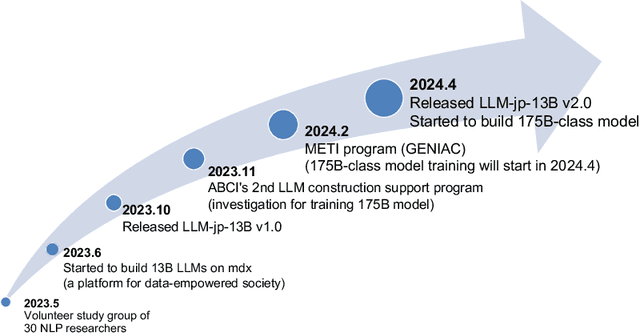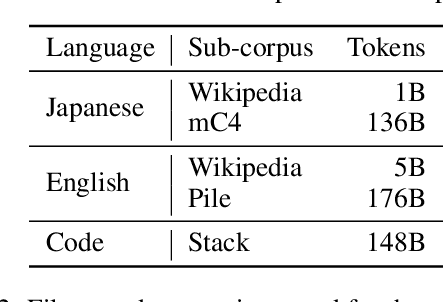Tatsuya Hiraoka
Investigating Neurons and Heads in Transformer-based LLMs for Typographical Errors
Feb 27, 2025Abstract:This paper investigates how LLMs encode inputs with typos. We hypothesize that specific neurons and attention heads recognize typos and fix them internally using local and global contexts. We introduce a method to identify typo neurons and typo heads that work actively when inputs contain typos. Our experimental results suggest the following: 1) LLMs can fix typos with local contexts when the typo neurons in either the early or late layers are activated, even if those in the other are not. 2) Typo neurons in the middle layers are responsible for the core of typo-fixing with global contexts. 3) Typo heads fix typos by widely considering the context not focusing on specific tokens. 4) Typo neurons and typo heads work not only for typo-fixing but also for understanding general contexts.
Number Representations in LLMs: A Computational Parallel to Human Perception
Feb 22, 2025Abstract:Humans are believed to perceive numbers on a logarithmic mental number line, where smaller values are represented with greater resolution than larger ones. This cognitive bias, supported by neuroscience and behavioral studies, suggests that numerical magnitudes are processed in a sublinear fashion rather than on a uniform linear scale. Inspired by this hypothesis, we investigate whether large language models (LLMs) exhibit a similar logarithmic-like structure in their internal numerical representations. By analyzing how numerical values are encoded across different layers of LLMs, we apply dimensionality reduction techniques such as PCA and PLS followed by geometric regression to uncover latent structures in the learned embeddings. Our findings reveal that the model's numerical representations exhibit sublinear spacing, with distances between values aligning with a logarithmic scale. This suggests that LLMs, much like humans, may encode numbers in a compressed, non-uniform manner.
The Geometry of Numerical Reasoning: Language Models Compare Numeric Properties in Linear Subspaces
Oct 17, 2024Abstract:This paper investigates whether large language models (LLMs) utilize numerical attributes encoded in a low-dimensional subspace of the embedding space when answering logical comparison questions (e.g., Was Cristiano born before Messi?). We first identified these subspaces using partial least squares regression, which effectively encodes the numerical attributes associated with the entities in comparison prompts. Further, we demonstrate causality by intervening in these subspaces to manipulate hidden states, thereby altering the LLM's comparison outcomes. Experimental results show that our findings hold for different numerical attributes, indicating that LLMs utilize the linearly encoded information for numerical reasoning.
Repetition Neurons: How Do Language Models Produce Repetitions?
Oct 17, 2024Abstract:This paper introduces repetition neurons, regarded as skill neurons responsible for the repetition problem in text generation tasks. These neurons are progressively activated more strongly as repetition continues, indicating that they perceive repetition as a task to copy the previous context repeatedly, similar to in-context learning. We identify these repetition neurons by comparing activation values before and after the onset of repetition in texts generated by recent pre-trained language models. We analyze the repetition neurons in three English and one Japanese pre-trained language models and observe similar patterns across them.
SubRegWeigh: Effective and Efficient Annotation Weighing with Subword Regularization
Sep 10, 2024Abstract:Many datasets of natural language processing (NLP) sometimes include annotation errors. Researchers have attempted to develop methods to reduce the adverse effect of errors in datasets automatically. However, an existing method is time-consuming because it requires many trained models to detect errors. We propose a novel method to reduce the time of error detection. Specifically, we use a tokenization technique called subword regularization to create pseudo-multiple models which are used to detect errors. Our proposed method, SubRegWeigh, can perform annotation weighting four to five times faster than the existing method. Additionally, SubRegWeigh improved performance in both document classification and named entity recognition tasks. In experiments with pseudo-incorrect labels, pseudo-incorrect labels were adequately detected.
LLM-jp: A Cross-organizational Project for the Research and Development of Fully Open Japanese LLMs
Jul 04, 2024



Abstract:This paper introduces LLM-jp, a cross-organizational project for the research and development of Japanese large language models (LLMs). LLM-jp aims to develop open-source and strong Japanese LLMs, and as of this writing, more than 1,500 participants from academia and industry are working together for this purpose. This paper presents the background of the establishment of LLM-jp, summaries of its activities, and technical reports on the LLMs developed by LLM-jp. For the latest activities, visit https://llm-jp.nii.ac.jp/en/.
An Analysis of BPE Vocabulary Trimming in Neural Machine Translation
Mar 30, 2024Abstract:We explore threshold vocabulary trimming in Byte-Pair Encoding subword tokenization, a postprocessing step that replaces rare subwords with their component subwords. The technique is available in popular tokenization libraries but has not been subjected to rigorous scientific scrutiny. While the removal of rare subwords is suggested as best practice in machine translation implementations, both as a means to reduce model size and for improving model performance through robustness, our experiments indicate that, across a large space of hyperparameter settings, vocabulary trimming fails to improve performance, and is even prone to incurring heavy degradation.
Knowledge of Pretrained Language Models on Surface Information of Tokens
Feb 22, 2024



Abstract:Do pretrained language models have knowledge regarding the surface information of tokens? We examined the surface information stored in word or subword embeddings acquired by pretrained language models from the perspectives of token length, substrings, and token constitution. Additionally, we evaluated the ability of models to generate knowledge regarding token surfaces. We focused on 12 pretrained language models that were mainly trained on English and Japanese corpora. Experimental results demonstrate that pretrained language models have knowledge regarding token length and substrings but not token constitution. Additionally, the results imply that there is a bottleneck on the decoder side in terms of effectively utilizing acquired knowledge.
Tokenization Tractability for Human and Machine Learning Model: An Annotation Study
Apr 21, 2023Abstract:Is tractable tokenization for humans also tractable for machine learning models? This study investigates relations between tractable tokenization for humans (e.g., appropriateness and readability) and one for models of machine learning (e.g., performance on an NLP task). We compared six tokenization methods on the Japanese commonsense question-answering dataset (JCommmonsenseQA in JGLUE). We tokenized question texts of the QA dataset with different tokenizers and compared the performance of human annotators and machine-learning models. Besides,we analyze relationships among the performance, appropriateness of tokenization, and response time to questions. This paper provides a quantitative investigation result that shows the tractable tokenizations for humans and machine learning models are not necessarily the same as each other.
Downstream Task-Oriented Neural Tokenizer Optimization with Vocabulary Restriction as Post Processing
Apr 21, 2023Abstract:This paper proposes a method to optimize tokenization for the performance improvement of already trained downstream models. Our method generates tokenization results attaining lower loss values of a given downstream model on the training data for restricting vocabularies and trains a tokenizer reproducing the tokenization results. Therefore, our method can be applied to variety of tokenization methods, while existing work cannot due to the simultaneous learning of the tokenizer and the downstream model. This paper proposes an example of the BiLSTM-based tokenizer with vocabulary restriction, which can capture wider contextual information for the tokenization process than non-neural-based tokenization methods used in existing work. Experimental results on text classification in Japanese, Chinese, and English text classification tasks show that the proposed method improves performance compared to the existing methods for tokenization optimization.
 Add to Chrome
Add to Chrome Add to Firefox
Add to Firefox Add to Edge
Add to Edge